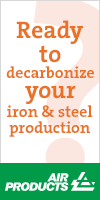EUROFER: EU Recovery is Broadening, Steel Market Balance Will Remain Fragile
04/17/2014 - Strengthening indicators and evidence of improving dynamics suggest that the EU economy is well on track for recovery this year and into 2015, EUROFER says.
The Q2-2014 outlook from EUROFER’s Economic Committee confirms that economic growth is expected to become more balanced across growth factors, also in the more vulnerable countries in the Eurozone periphery, owing to reforms strengthening particularly the export sector.
EUROFER director general Gordon Moffat commented: “The mood of negativism is clearly fading as economic conditions stabilise and short-term visibility of the domestic markets improves. The private sector looks more willing to invest again, particularly if credit conditions would ease further. Also international investors are returning to the EU. That’s good news for downstream steel users.”
Meanwhile, the report also signals that while the EU recovery is gradually building up some staying power, risks remain. While delays in the implementation of reforms and the current strength of the Euro in combination with longer-term low inflation could slow economic growth in the EU, external risks have come to the fore lately.
Financial market turmoil in several emerging economies, in particular Brazil, India, Indonesia, Turkey and South Africa have led to capital outflows and overnight currency crunches. Monetary action to stabilize the situation will slow their economies.
Further escalation of the conflict between the Ukraine and Russia would not only hurt Russia but also the EU economy because of its trade ties with Russia.
As such, the global economic context looks currently more uncertain; this jeopardizes the expected synchronized recovery of the industrialized economies.
The base case scenario for the EU steel market is for a gradual but slow and fragile recovery of demand in 2014 and 2015, driven by improving activity in the key steel using sectors and some restocking. Despite the expected rise in apparent consumption — almost 3.5% in 2014 and 3% in 2015 — the gap with pre-crisis demand levels will remain significant.
Moffat added: “As far as supply is concerned, we are concerned about imports from third countries into the EU. Steel trade data show imports remaining at a high level in Q1-2014, attracted by the strong Euro and uptrend in demand. This threatens to distort market conditions in the EU which are already extremely difficult for EU steel producers”.
EUROFER director general Gordon Moffat commented: “The mood of negativism is clearly fading as economic conditions stabilise and short-term visibility of the domestic markets improves. The private sector looks more willing to invest again, particularly if credit conditions would ease further. Also international investors are returning to the EU. That’s good news for downstream steel users.”
Meanwhile, the report also signals that while the EU recovery is gradually building up some staying power, risks remain. While delays in the implementation of reforms and the current strength of the Euro in combination with longer-term low inflation could slow economic growth in the EU, external risks have come to the fore lately.
Financial market turmoil in several emerging economies, in particular Brazil, India, Indonesia, Turkey and South Africa have led to capital outflows and overnight currency crunches. Monetary action to stabilize the situation will slow their economies.
Further escalation of the conflict between the Ukraine and Russia would not only hurt Russia but also the EU economy because of its trade ties with Russia.
As such, the global economic context looks currently more uncertain; this jeopardizes the expected synchronized recovery of the industrialized economies.
The base case scenario for the EU steel market is for a gradual but slow and fragile recovery of demand in 2014 and 2015, driven by improving activity in the key steel using sectors and some restocking. Despite the expected rise in apparent consumption — almost 3.5% in 2014 and 3% in 2015 — the gap with pre-crisis demand levels will remain significant.
Moffat added: “As far as supply is concerned, we are concerned about imports from third countries into the EU. Steel trade data show imports remaining at a high level in Q1-2014, attracted by the strong Euro and uptrend in demand. This threatens to distort market conditions in the EU which are already extremely difficult for EU steel producers”.



-(220-x-200-px)-(130-x-130-px)-(220-x-200-px).jpg?lang=en-US&ext=.jpg)
.gif?width=200&height=200&mediaprotectionhash=ddb07947ad3b4ab959a83714461eccd5c6895f370695eb035a9ff7aa736f8ad9&ext=.gif)





